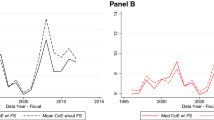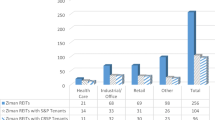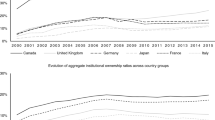Abstract
We examine the extent to which 50,620 global institutional investors’ specialization in publicly traded real estate securities is related to their investment performance. Consistent with the information advantage theory (Merton Journal of Finance 42, 483–510, 1987; Van Nieuwerburgh and Veldkamp Journal of Finance, 64, 1187–1215, 2009), we show a positive relation between the percentage of the institution’s portfolio invested in real estate securities and the return generated on those securities. Moreover, we present evidence that the institution’s level of active share to real estate securities is positively related to performance. Additionally, we find that the benefits related to specialization are more pronounced for investors specializing in a narrow set of securities that requires a unique set of skills to analyze.


Similar content being viewed by others
Notes
When we discuss real estate securities, we are referring to operating firms that are dependent on the real estate sectors. Table Error! Reference source not found. shows the Standard Industrial Classification (SCI) codes of the firms we classify as “real estate securities.” REITs belong to SIC 6798.
The assertion that REITs require unique expertise is supported by Cici et al. (2011). The authors find that some mutual fund managers can better process REIT-specific information that leads to profitable investment decisions. The authors conclude that outperformance in REITs derives from “endemic abilities” of the managers to process information.
Papers that examine institutional investors in real estate include: Ciochetti, Craft, and Shilling (2002)‘s study of institutional investors’ liquidity concerns; Lantushenko and Nelling’s (2016) and Freybote and Seagraves’ (2017) studies on institutions’ herding behavior in real estate; Devos, Ong, Speiler, and Tsang’s (2013) and Das, Freybote, and Marcato’s (2014) studies on institutional investor behavior, before, during, and after the financial crisis; An, Wu, and Wu’s (2016) study on the relation between institutional ownership and REIT crash risk.
For institutions with multiple portfolios, FactSet provides holdings information for each portfolio. We treat each portfolio as an individual observation throughout the analyses.
We exclude banks and insurance investors from the sample due to their small sample size. We also exclude index funds because they, by definition, do not attempt to outperform the passive index.
We note that a firm must hold at least ten real estate or REIT securities to be included in our active share analysis.
We obtain the systematic risk factors from Kenneth French’s data library. The data have been used previously in global performance studies (e.g., Fama and French 2012).
We observe qualitatively similar results if we include banks and insurance companies in our sample.
The list of tax-havens includes Hong Kong, Andorra, the Bahamas, Bermuda, the Cayman Islands, Cyprus, Gibraltar, Iceland, Monaco, and Malta.
This 3.04% annual Alpha is based on the Alphas reported in specification 2 and 5. Specifically, 0.0304 = 4 * (0.0019 – (−0.0057)).
The −2.2% annual return is calculated as follows: 4 x (0.1 x (−0.0538)) = −0.02152.
References
Ambrose, B. W., Cao, C., & D’Lima, W. (2016). Real estate risk and hedge fund returns. Journal of Real Estate Finance and Economics, 52, 197–225.
Bond, S. A., & Mitchell, P. (2010). Alpha and persistence in real estate fund performance. Journal of Real Estate Finance and Economics, 41, 53–79.
Chen, J., Hong, H., Huang, M., & Kubik, J. D. (2004). Does fund size erode mutual fund performance? The role of liquidity and organization. American Economic Review, 94(5), 1276-1302
Chiang, K. H., Kozhevnikov, K., Lee, M.-L., & Wisen, C. H. (2008). Further evidence on the performance of funds of funds: The case of real estate mutual funds. Real Estate Economics, 36(1), 47–61.
Choi, N., Fedenia, M., Skiba, H., & Sokolyk, T. (2017). Portfolio concentration and performance of institutional investors worldwide. Journal of Financial Economics, 123(1), 189–208.
Chou, W.-H., & Hardin III, W. G. (2014). Performance chasing, fund flows and fund size in real estate mutual funds. Journal of Real Estate Finance and Economics, 49, 379–412.
Cici, G., Corgel, J., & Gibson, S. (2011). Can fund managers select outperforming REITs? Examining fund holdings and trades. Real Estate Economics, 39(3), 455–486.
Coval, J. D., & Moskowitz, T. J. (2001). The geography of investment: Informed trading and asset prices. Journal of Political Economy, 109(4), 811–841.
Cremers, M., & Petajisto, A. (2009). How active is your fund manager? A new measure that predicts performance. The Review of Financial Studies, 22(9), 3329–3365.
Devos, E., Ong, S.-E., Spieler, A. C., & Tsang, D. (2013). REIT institutional ownership dynamics and the financial crisis. Journal of Real Estate Finance and Economics, 47, 266–288.
Edward, S., & Daniel, E. (2000). Real estate mutual funds: Abnormal performance and fund characteristics. Journal of Real Estate Portfolio Management, 6(3), 239–247.
Fama, E., & French, K. (2012). Size, value and momentum in international stock returns. Journal of Financial Economics, 105, 457–472.
Freybote, J., & Seagraves, P. A. (2017). Heterogeneous investor sentiment and institutional real estate investments. Real Estate Economics, 45(1), 154–176.
Han, S., Kin, W., & Wang, K. (1998). Institutional investment in REITs: Evidence and implications. Journal of Real Estate Research, 16(3), 357–374.
Hartzell, J. C., Mühlhofer, T., & Titman, S. (2010). Alternative benchmarks for evaluating mutual fund performance. Real Estate Economics, 38(1), 121–154.
Ivković, Z., Sialm, C., & Weisbenner, S. (2008). Portfolio concentration and the performance of individual investors. Journal of Financial and Quantitative Analysis, 43, 613–656.
Kacperczyk, M., Sialm, C., & Zheng, L. (2005). On the industry concentration of actively managed equity mutual funds. Journal of Finance, 60, 1983–2011.
Kallberg, J. G., Liu, C. L., & Trzcinka, C. (2000). The value added from investment managers: An examination of funds of REITs. Journal of Financial and Quantitative Analysis, 35, 387–408.
Ling, D.C.Naranjo, A., & Scheick, B. (2018). There’s no place like home: Information asymmetries, local asset concentration, and portfolio returns. Working paper.
Merton, R. C. (1987). A simple model of capital market equilibrium with incomplete information. Journal of Finance, 42, 483–510.
Sharpe, W. F. (1964). Capital asset prices: A theory of market equilibrium under conditions of risk. The Journal of Finance, 19(3), 425–442.
Van Nieuwerburgh, S., & Veldkamp, L. (2009). Information immobility and the home bias puzzle. Journal of Finance, 64, 1187–1215.
Author information
Authors and Affiliations
Corresponding author
Additional information
Publisher’s Note
Springer Nature remains neutral with regard to jurisdictional claims in published maps and institutional affiliations.
Appendix
Appendix
Sample description by investor’s domicile
The Appendix shows the sample averages for portfolio weights of real estate securities and REITs by institutions’ domiciles. The first column shows the number of investors from each domicile during the sample period and the last two columns show the average portfolio weights in real estate related securities and REITs. The table includes all investors with at least some portfolio weight in either real estate securities or REITs.
Number of investors | Portfolio weight | Number of investors | Portfolio weight | ||||||
|---|---|---|---|---|---|---|---|---|---|
Domicile | RE | REIT | RE | REIT | Domicile | RE | REIT | RE | REIT |
AND | 2 | 0.0617 | KEN | 1 | 0.0615 | ||||
ARE | 26 | 1 | 0.3157 | 0.0175 | KOR | 89 | 8 | 0.0386 | 0.0153 |
ARG | 6 | 1 | 0.0823 | 0.0095 | KWT | 7 | 0.2104 | ||
AUS | 596 | 254 | 0.1848 | 0.1845 | LBN | 1 | 0.2150 | ||
AUT | 461 | 192 | 0.0990 | 0.0600 | LIE | 123 | 45 | 0.1015 | 0.0681 |
BEL | 520 | 344 | 0.0561 | 0.0470 | LKA | 3 | 0.2525 | ||
BGR | 2 | 1 | 0.0472 | 0.1513 | LTU | 11 | 3 | 0.1248 | 0.0599 |
BHR | 5 | 0.0834 | LUX | 644 | 303 | 0.0578 | 0.0485 | ||
BHS | 25 | 10 | 0.0348 | 0.0118 | LVA | 6 | 1 | 0.0517 | 0.0107 |
BMU | 17 | 6 | 0.0582 | 0.0188 | MCO | 1 | 1 | 0.0590 | 0.1751 |
BOL | 1 | 0.0489 | MEX | 110 | 18 | 0.1174 | 0.1994 | ||
BRA | 912 | 12 | 0.1397 | 0.0258 | MLT | 10 | 2 | 0.0590 | 0.5162 |
CAN | 1959 | 1310 | 0.0489 | 0.0593 | MUS | 1 | 0.4795 | ||
CHE | 1675 | 807 | 0.0701 | 0.0511 | MYS | 259 | 166 | 0.0931 | 0.0603 |
CHL | 172 | 25 | 0.0965 | 0.0570 | NAM | 5 | 5 | 0.0720 | 0.0349 |
CHN | 585 | 12 | 0.0691 | 0.1557 | NLD | 533 | 355 | 0.1002 | 0.1125 |
CYM | 4 | 3 | 0.0454 | 0.0378 | NOR | 261 | 96 | 0.0409 | 0.0189 |
CYP | 1 | 0.0442 | NZL | 22 | 13 | 0.1038 | 0.0945 | ||
CZE | 27 | 11 | 0.1157 | 0.0734 | OMN | 6 | 0.1574 | ||
DEU | 4787 | 1454 | 0.0370 | 0.0296 | PAK | 27 | 0.0243 | ||
DNK | 445 | 249 | 0.0435 | 0.0300 | PHL | 10 | 1 | 0.1624 | 0.0130 |
EGY | 1 | 0.3377 | POL | 231 | 104 | 0.0821 | 0.0219 | ||
ESP | 4669 | 1043 | 0.0657 | 0.1084 | PRT | 185 | 37 | 0.0408 | 0.0195 |
EST | 26 | 18 | 0.1056 | 0.0416 | QAT | 1 | 0.0903 | ||
FIN | 277 | 82 | 0.0807 | 0.0879 | ROU | 9 | 0.1203 | ||
FRA | 3022 | 1172 | 0.0606 | 0.0455 | RUS | 10 | 5 | 0.0898 | 0.0909 |
GBR | 5624 | 3952 | 0.0543 | 0.0561 | SAU | 21 | 2 | 0.1587 | 0.3813 |
GIB | 2 | 2 | 0.0529 | 0.0140 | SGP | 521 | 286 | 0.1034 | 0.0622 |
GRC | 88 | 30 | 0.0451 | 0.0246 | SVK | 17 | 5 | 0.3294 | 0.0828 |
HKG | 755 | 359 | 0.1230 | 0.0408 | SVN | 81 | 40 | 0.0413 | 0.0416 |
HRV | 27 | 9 | 0.1559 | 0.0955 | SWE | 733 | 277 | 0.0496 | 0.0188 |
HUN | 35 | 15 | 0.0824 | 0.0367 | THA | 227 | 1 | 0.0347 | 0.0100 |
IDN | 18 | 0.0618 | TTO | 1 | 1 | 0.0396 | 0.0484 | ||
IND | 1061 | 6 | 0.0660 | 0.0253 | TUR | 25 | 24 | 0.0458 | 0.0467 |
IRL | 292 | 169 | 0.0386 | 0.0255 | TWN | 404 | 124 | 0.0745 | 0.0743 |
ISL | 4 | 1 | 0.0447 | 0.0314 | USA | 11,476 | 10,338 | 0.0443 | 0.0845 |
ISR | 699 | 397 | 0.1425 | 0.0475 | VNM | 8 | 4 | 0.1422 | 0.1193 |
ITA | 873 | 343 | 0.0406 | 0.0381 | ZAF | 575 | 472 | 0.0908 | 0.0975 |
JOR | 1 | 0.1285 | ZWE | 2 | 0.1249 | ||||
JPN | 1e722 | 435 | 0.0648 | 0.2192 | |||||
Total (Avg) | 48,081 | 25,462 | (0.0990) | (0.0740) | |||||
Rights and permissions
About this article
Cite this article
Beracha, E., Cashman, G.D. & Skiba, H. Specialization and Institutional Investors’ Performance – Evidence from Publicly Traded Real Estate. J Real Estate Finan Econ 62, 48–80 (2021). https://doi.org/10.1007/s11146-019-09732-w
Published:
Issue Date:
DOI: https://doi.org/10.1007/s11146-019-09732-w




